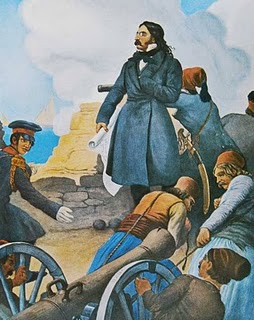First siege of Missolonghi
This article needs additional citations for verification. (August 2011) |
| First Siege of Missolonghi | |||||||
|---|---|---|---|---|---|---|---|
| Part of the Greek War of Independence | |||||||
 Alexandros Mavrokordatos defends Missolonghi by Peter von Hess | |||||||
| |||||||
| Belligerents | |||||||
|
|
| ||||||
| Commanders and leaders | |||||||
|
|
| ||||||
| Strength | |||||||
| ca. 2,000 | ca. 8,000 | ||||||
The First Siege of Missolonghi [1] was an attempt by Ottoman forces to capture the strategically located port town of Missolonghi during the early stages of the Greek War of Independence.
Siege
After the Battle of Peta, Omer Vryonis initially tried to take the town by negotiations, against the opinion of Reşid Mehmed and Yussuf Pasha of Patras. The besieged Greeks took advantage of this, dragging the negotiations out until November 8, when they were reinforced by sea with over 1,500 fighters. Then the Ottomans realized their mistake, and resumed the siege in earnest. After a month of bombardment and sorties, the main Ottoman assault was set for the night of December 24, before Christmas, calculating that the Greeks would be caught by surprise. The Greeks however were warned by Vryonis' Greek secretary, and the attack failed. The siege was subsequently lifted on December 31.[2][3]
Aftermath
Missolonghi remained under Greek control, and resisted another Ottoman attempt at its capture a year later. Its resistance achieved wider fame when Lord Byron arrived there, dying in the town of fever in April 1824. The city was besieged for a third and final time, resisting both Ottoman and Egyptian armies for almost a year, until its final fall on April 10, 1826.
See also
- Dimitrios Deligeorgis, a battery commander during the first siege
- Second Siege of Missolonghi
- Third Siege of Missolonghi
References
38°22′05″N 21°25′41″E / 38.3680°N 21.4280°E
